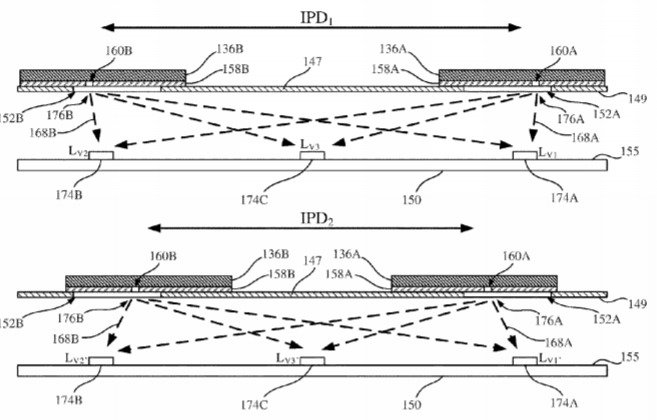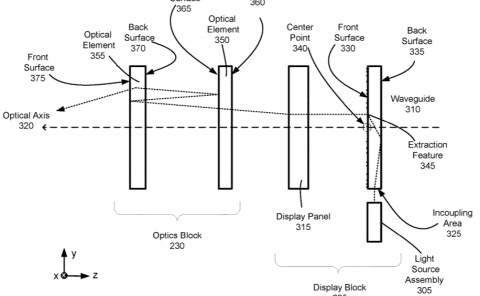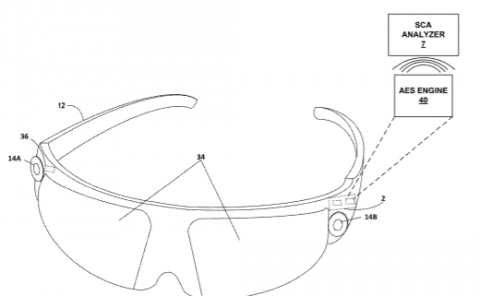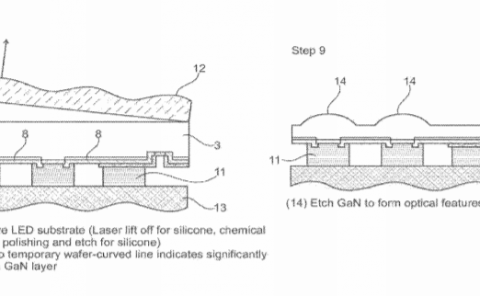Facebook Patent | Apparatuses, Systems, And Methods For Determining Interpupillary Distances Of Head-Mounted Displays
Patent: Apparatuses, Systems, And Methods For Determining Interpupillary Distances Of Head-Mounted Displays
Publication Number: 10674141
Publication Date: 20200602
Applicants: Facebook

Abstract
A head-mounted-display system may include 1) a support assembly and 2) a pair of display assemblies moveably coupled to the support assembly such that the display assemblies are moveable between a plurality of positions corresponding to a plurality of user interpupillary distances, with the pair of display assemblies respectively defining separate viewing regions for a user’s right and left eyes. Each of the pair of display assemblies may include a lens and a display screen. The head-mounted-display system may also include a detection subsystem having 1) at least one position sensor and 2) a determination module that determines a positional relationship between the pair of display assemblies based on measurements obtained by the at least one position sensor. Various other methods, systems, and computer-readable media are also disclosed.
BACKGROUND
Virtual reality and augmented reality headsets are widely gaining in popularity for use in a growing number of activities. Such headsets may integrate visual information into a user’s field of view to enhance their surroundings or allow them to step into immersive three-dimensional environments. While virtual reality and augmented reality headsets are often utilized for gaming and other entertainment purposes, they are also commonly employed for purposes outside of recreation–for example, governments may use them for military training simulations, doctors may use them to practice surgery, and engineers may use them as visualization aids. Virtual and augmented reality systems are also increasingly recognized for their utility in facilitating inter-personal interactions between individuals in a variety of contexts.
Such headsets commonly include display and optical elements that project separate images to the eyes of users so that the users perceive three-dimensional content. Unfortunately, variations in the shapes of human faces may present difficulties in properly displaying these images to users. For example, variations in users’ interpupillary distances (i.e., the distance between a person’s eyes) may cause discomfort to users due to optical distortions, eye strain, and/or facial discomfort if display elements are not precisely configured to accommodate such variations. Because of this, traditional virtual reality and augmented reality headsets may include adjustment mechanisms to tailor the spacing between optical elements to more precisely fit each user’s unique interpupillary distance. In addition, measurement devices, such as linear potentiometers, may be utilized to determine distances between optical elements of headsets to ensure that content is properly displayed to users. Unfortunately, such measurements devices may be mechanically complex and bulky and may impede smooth and precise adjustment of the optical elements.
SUMMARY
As will be described in greater detail below, the instant disclosure describes apparatuses, systems, and methods for determining interpupillary distances of head-mounted displays. For example, a head-mounted-display system may include 1) a support assembly and 2) a pair of display assemblies moveably coupled to the support assembly such that the pair of display assemblies are moveable between a plurality of positions corresponding to a plurality of user interpupillary distances, with the pair of display assemblies respectively defining separate viewing regions for a user’s right and left eyes. In some embodiments, each of the pair of display assemblies may include a lens and a display screen having a display area that projects image light toward the lens. The head-mounted-display system may also include a detection subsystem having 1) at least one position sensor that measures emissions from a tracked region of at least one display assembly of the pair of display assemblies and 2) a determination module that determines a positional relationship between the pair of display assemblies based on the emissions measured by the at least one position sensor. According to some embodiments, the positional relationship between the pair of display assemblies may include a user interpupillary distance corresponding to a position of the pair of display assemblies with respect to each other.
The at least one position sensor may include at least one optical sensor that measures quantities of light emitted from the tracked region of the at least one display assembly. In this example, the tracked region of the at least one display assembly may include a tracking opening defined in a back light-blocking layer of the display screen of the at least one display assembly that is disposed opposite a front surface of the display screen of the at least one display assembly through which image light is projected. A portion of light generated by the display screen may pass through the tracking opening. In at least one example, the support assembly may include a dividing member extending between the display screen of the at least one display assembly and the at least one optical sensor. A dividing-member opening may be defined in a portion of the dividing member that at least partially overlaps the tracking opening defined in the back light-blocking layer of the display screen of the at least one display assembly. The tracking opening defined in the back light-blocking layer of the display screen of the at least one display assembly may extend longitudinally in a first direction parallel to a back surface of the back light-blocking layer. The dividing-member opening defined in the dividing member of the support assembly may extend longitudinally in a second direction that is nonparallel to the first direction.
According to various embodiments, the head-mounted-display system may further include at least one reflective element for reflecting at least a portion of the light emitted from the tracked region of the at least one display assembly toward the at least one optical sensor. The at least one reflective element may be disposed outside the pair of display assemblies. Additionally or alternatively, the head-mounted-display system may further include at least one collimator for directing at least a portion of light emitted from the tracked region of the at least one display assembly toward the at least one optical sensor. The tracked region of the at least one display assembly may include a magnetic element. In this example, the at least one position sensor may include at least one magnetic field sensor that measures a magnetic field emitted by the magnetic element. The at least one magnetic field sensor may be, for example, a magnetoresistive sensor.
In some embodiments, the at least one position sensor may include a plurality of discrete position sensors that each measure the emissions from the tracked region of the at least one display assembly. In this example, the determination module may determine the positional relationship between the pair of display assemblies based on the emissions measured by the plurality of discrete position sensors. In at least one embodiment, the tracked region of the at least one display assembly may be located outside the display area. Additionally or alternatively, the tracked region of the at least one display assembly may be located on a back surface of the display screen of the at least one display assembly that is opposite a front surface of the display screen of the at least one display assembly through which image light is projected. In some examples, the at least one position sensor may be disposed on a printed circuit board. The head-mounted-display system may include a display adjustment assembly for adjusting positions of the pair of display assemblies with respect to each other.
A corresponding head-mounted-display device may include 1) a display housing, 2) a support assembly mounted to the display housing, 3) a pair of display assemblies moveably coupled to the support assembly, and 4) a detection subsystem. According to some embodiments, the display housing may include a viewing opening and an end surface disposed opposite the viewing opening. In this example, the at least one position sensor may be disposed between the tracked region of the at least one display assembly and the end surface of the display housing.
In addition, a corresponding method may include measuring, by at least one position sensor of a detection subsystem, emissions from a tracked region of at least one display assembly of a pair of display assemblies of a head-mounted-display system, with the pair of display assemblies moveably coupled to a support assembly such that the pair of display assemblies are moveable between a plurality of positions corresponding to a plurality of user interpupillary distances and the pair of display assemblies respectively defining separate viewing regions for a user’s right and left eyes. Each of the pair of display assemblies may include a lens and a display screen having a display area that projects image light toward the lens. The method may also include determining, by a determination module, a positional relationship between the pair of display assemblies based on the emissions measured by the at least one position sensor.
In at least one embodiment, the method may include 1) adjusting, by a display adjustment assembly, positions of the pair of display assemblies with respect to each other, 2) measuring, by the at least one position sensor of the detection subsystem, additional emissions from the tracked region of the at least one display assembly of the pair of display assemblies disposed in the adjusted positions, and 3) determining, by the determination module, an adjusted positional relationship between the pair of display assemblies based on the additional emissions measured by the at least one position sensor.
Features from any of the above-mentioned embodiments may be used in combination with one another in accordance with the general principles described herein. These and other embodiments, features, and advantages will be more fully understood upon reading the following detailed description in conjunction with the accompanying drawings and claims.
BRIEF DESCRIPTION OF THE DRAWINGS
The accompanying drawings illustrate a number of exemplary embodiments and are a part of the specification. Together with the following description, these drawings demonstrate and explain various principles of the instant disclosure.
FIG. 1 is a perspective view of an exemplary head-mounted-display system in accordance with some embodiments.
FIG. 2 is a block diagram of an exemplary display system in accordance with some embodiments.
FIGS. 3A and 3B are front views of an exemplary head-mounted-display device in accordance with some embodiments.
FIG. 4 is a cross-sectional side view of an exemplary head-mounted-display device in accordance with some embodiments.
FIG. 5 is a cross-sectional side view of an exemplary display screen and a portion of a dividing member in accordance with some embodiments.
FIG. 6 is a rear view of exemplary left- and right-eye display screens in accordance with some embodiments.
FIG. 7 is a rear view of an exemplary dividing member in accordance with some embodiments.
FIG. 8 is a front view of an exemplary printed circuit board and a plurality of mounted optical sensors in accordance with some embodiments.
FIGS. 9A and 9B are rear views of exemplary left- and right-eye display screens and an exemplary dividing member in accordance with some embodiments.
FIGS. 10A and 10B are cross-sectional top views of exemplary left- and right-eye display screens, an exemplary dividing member, and exemplary optical sensors mounted on a printed circuit board in accordance with some embodiments.
FIGS. 11A-11C are rear views of exemplary left- and right-eye display screens and an exemplary dividing member in accordance with some embodiments.
FIGS. 12A-12C are rear views of exemplary left- and right-eye display screens and an exemplary dividing member in accordance with some embodiments.
FIGS. 13A and 13B are top views of exemplary left- and right-eye display screens and exemplary optical sensors mounted on a printed circuit board in accordance with some embodiments.
FIG. 14 is a front view of an exemplary display screen in accordance with some embodiments.
FIG. 15 is a top view of an exemplary display screen and an exemplary magnetic field sensor mounted on a printed circuit board in accordance with some embodiments.
FIG. 16 is a rear view of an exemplary magnetic element and an exemplary magnetic field sensor mounted on a printed circuit board in accordance with some embodiments.
FIG. 17** is a diagram of an exemplary system for determining interpupillary distances of head-mounted displays in accordance with some embodiments**
FIG. 18 is an exemplary graph showing a relationship between a signal obtained by the system of FIG. 17 and a position of a display screen.
FIG. 19 is a flow diagram of an exemplary method for determining interpupillary distances of head-mounted displays in accordance with some embodiments.
FIGS. 20A and 20B are partial cross-sectional top views of a portion of an exemplary head-mounted-display device in accordance with some embodiments.
FIG. 21 is a flow diagram of an exemplary method for calibrating proximity sensors of head-mounted displays in accordance with some embodiments.
Throughout the drawings, identical reference characters and descriptions indicate similar, but not necessarily identical, elements. While the exemplary embodiments described herein are susceptible to various modifications and alternative forms, specific embodiments have been shown by way of example in the drawings and will be described in detail herein. However, the exemplary embodiments described herein are not intended to be limited to the particular forms disclosed. Rather, the instant disclosure covers all modifications, equivalents, and alternatives falling within the scope of the appended claims.
DETAILED DESCRIPTION OF EXEMPLARY EMBODIMENTS
The present disclosure is generally directed to apparatuses, systems, and methods for determining interpupillary distances of head-mounted displays. As will be explained in greater detail below, embodiments of the instant disclosure may include a head-mounted-display system having a pair of display assemblies that are moveable between a plurality of positions corresponding to a plurality of user interpupillary distances. The pair of display assemblies may respectively define separate viewing regions for a user’s right and left eyes and may each include, for example, an eye cup, a lens, and/or a display screen. The head-mounted-display system may include a detection subsystem having at least one sensor that measures emissions (e.g., emitted light, a magnetic field, etc.) from a tracked region of at least one display assembly of the pair of display assemblies. The detection subsystem may also include a determination module that determines a positional relationship between the pair of display assemblies based on the emissions measured by the at least one sensor.



